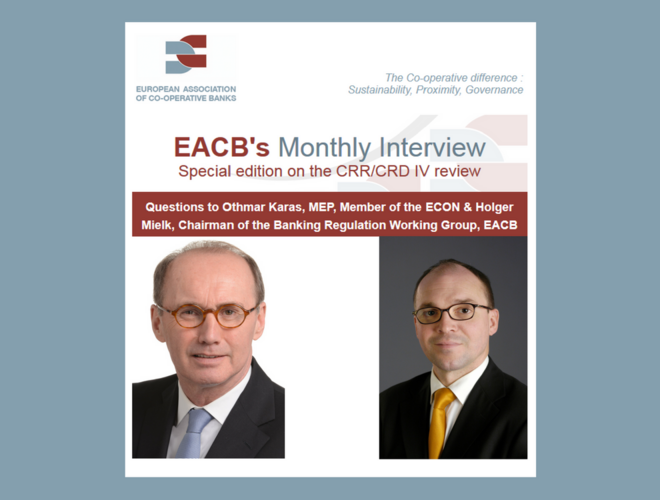In this November special edition, 2 interviews to:
Othmar Karas, MEP, ECON
& Holger Mielk, Chairman of the Banking regulation WG, EACB

Dear Mr. Karas, as Chairman of the SMEs Intergroup at the European Parliament and shadow rapporteur on the CRR/CRDIV review, you have recently hosted a breakfast meeting on "The CRR/CRD IV review: Impact on Financing the Real Economy and Co-operative Banks" in collaboration with the EACB, what are your views on this crucial topic?
In the course of the ongoing CRDIV/CRR-review the diversity of the European banking landscape and the voices of all affected stakeholders need to be thoroughly taken into account. This is why I welcome last week’s SME Intergroup debate with the European Association of Co-operative Banks on the implications for local and retail banks and their contribution to the financing of the real economy. Smaller and regional institutions are more domestically-focused, have different risk profiles and interdependencies with the economy and often face higher implementation costs of regulation than financial institutions which are larger and globally active. I therefore fully support the extension of the principle of proportionality from a regulatory and supervisory perspective by introducing effective measures to reduce administrative and organisational burden such as in reporting or disclosure requirements.

The risk reduction measures package with the review of the CRR/CRD is a key element towards further strengthening of the prudential framework. What do you see as key issues in this context, which elements pose the greatest challenges?
Indeed, the risk reduction measures package is of utmost importance for all credit institutions in Europe. In the context of the proposed changes to the CRR, the trading book/market risk issues together with the proposed changes for the large exposure regimes are areas that might lead to challenges for the institutions. The introduction of NSFR is completely new and somewhat unknown territory for all of us. Therefore, it is hard to predict how challenging it will be for the institutions to adapt to these new rules. Beside this, IFRS9 seems to be an issue of serious concern for many addressees of the new rules. However, it seems to me that with the fast track procedure, we are on a good way forward. In the area of the CRD, the proposals to the SREP and the pillar two requirements, including the pillar two guidance, as well as the proposals dealing with the Interest Rate Risk in the Banking Book have to be kept in mind. Last but not least, particularly for a German representative, the Proportionality issue is an area where improvement is needed. Especially for small and medium sized banks, the regulatory burden has reached a level that is not acceptable anymore and – more importantly – is also not necessary for a prudential framework in the banking sector. The most important task in this context is to change the framework in a way that leads to a substantial relief for the small and medium sized banks without creating competitive disadvantages and thus an unlevelled playing field for others. This might not be easy to achieve, but I am convinced that we can achieve more than what is on the table at the moment.
In the light of the recent debate organised by the EACB on the CRR review and SMEs’ financing what are the EACB main concerns and recommendations to continue sustaining the local economy?
The proposal from the Commission to extend the scope of the SMEs’ supporting factor is certainly a welcome step, together with the work being done for long term finance projects. What we would like to stress however is that banks need to be able to form sound expectations in terms of the prudential requirements and costs they will face over the years, in order to consistently plan also their credit policies, thus legal certainty and regulatory stability are needed and the reforms should finally consolidate.
It should also be reminded that when calibrating capital and liquidity requirements, resolution obligations etc., this should be done with a clear view on the consequences in terms of resource allocation and impact on the provision of credit to the economy.
Which other recent or upcoming initiatives in the prudential field are or will be the most relevant for EACB?
I presume that the developments around the ESA review will be an important issue in the future. This issue is connected to other important points, mainly Brexit and consumer protection in the financial sector, which seems to become a more and more important field of activity of European regulators and supervisors. Although, it is not in the main focus of my specific work as chair of the Banking Regulation Working Group, the MiFID II/MiFIR project will have an intensive impact in a lot of areas of capital market regulation in Europe. Beside this, the megatrends of digitalization and of questions of sustainability and the environment will also have an impact on the regulatory setting of institutions in the near future.



